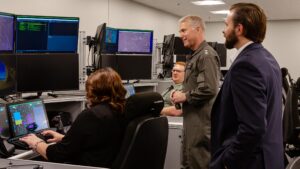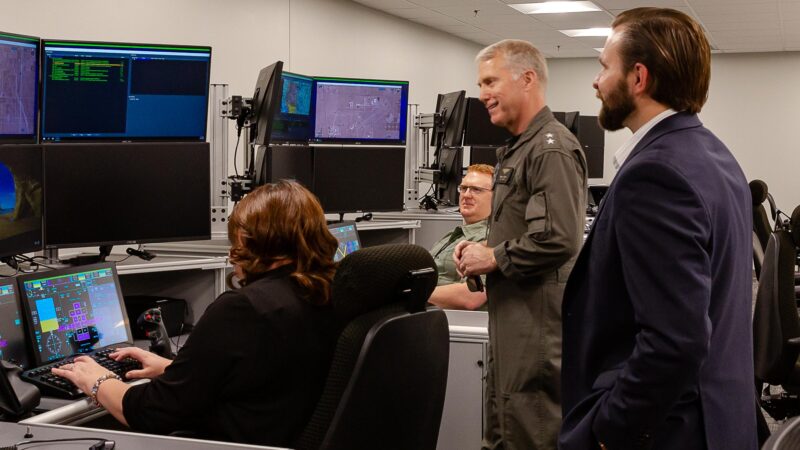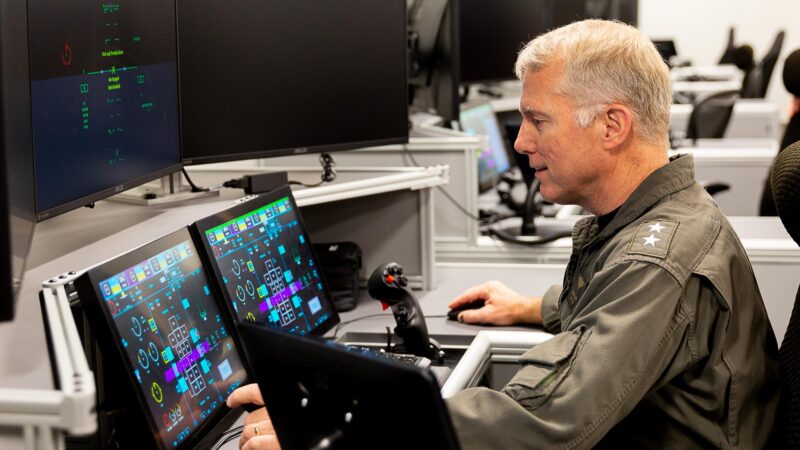
Rear Adm. Brian Corey, who oversees the Program Executive Officer for Unmanned Aviation and Strike Weapons, observes an MQ-25 engineer demonstrate the functionality of the unmanned system’s MD-5 Ground Control Station (GCS) May 17 at the System Test and Integration Lab in Patuxent River, Md. (U.S. Navy photo)
The Navy’s Unmanned Carrier Aviation program office (PMA-268) is moving forward with integrating its two key elements—the MQ-25 air vehicle and the MD-5 Ground Control Station (GCS) at the program’s System Test and Integration Lab (STIL) at Patuxent River.
PMA-268 is the lead systems integrator, working closely with its two prime industry partners, Boeing and Lockheed Martin Skunk Works ®, to ensure the expeditious integration of the MQ-25 Stingray Air Vehicle, the MD-5 GCS, and Aircraft Carrier (CVN) modifications required to support MQ-25 operations.
The MD-5 GCS is part of the Unmanned Carrier Aviation Mission Control System (UMCS), the system-of-systems required for MQ-25A command and control. UMCS also includes CVN and shore site infrastructure modifications, Navy produced ancillary equipment, and integration with command, control, communications, computers and intelligence (C4I) systems.
Rear Adm. Brian Corey, who oversees the Program Executive Office for Unmanned Aviation and Strike Weapons, visited the lab May 17 for a firsthand look at the equipment required to operate MQ-25.
“It is great to see momentum with GCS following the successful MQ-25 flight demonstrations last year,” he said to the government/industry team. “The air vehicle and GCS are equally important to this program and this is the team that is going to stitch it together.”
Just recently, Lockheed Martin delivered the latest System Developmental Release (SDR) to the Navy, and plans to help integrate the MD-5 system with the air vehicle next month.
“This will be the first time we are integrating an air vehicle and GCS from two different prime contractors,” said T.J. Maday, MQ-25 labs and integration manager. “And this is all being done with the government as the lead system integrator (LSI) within the government lab.”
Early integration allows for risk reduction and integration testing between the air vehicle and ground control station and provides the opportunity to ensure network connectivity between development environments are functional.
Lockheed Martin also recently delivered two MD-5 GCS stations to Webster Outlying Field in Saint Inigoes, Maryland to support MQ-25’s Test Transportable control stations. These will be the first assets to control the MQ-25’s initial UMCS flight in the 2023 timeframe.
The MQ-25 will be the world’s first operational, carrier-based unmanned aircraft. It will provide an aerial refueling capability that extends the range, operational capability and lethality of the carrier air wing.

Rear Adm. Brian Corey, who oversees the Program Executive Officer for Unmanned Aviation and Strike Weapons, observes an MQ-25 engineer demonstrate the functionality of the unmanned system’s MD-5 Ground Control Station (GCS) May 17 at the System Test and Integration Lab in Patuxent River, Md. (U.S. Navy photo)

Rear Adm. Brian Corey, who oversees the Program Executive Officer for Unmanned Aviation and Strike Weapons, gets a firsthand look at the Ground Control Station (GCS) for the MQ-25 unmanned air vehicle May 17 at the System Test and Integration Lab (STIL) at Patuxent River, Md. The GCS will be installed on aircraft carriers to operate MQ-25 in the future. (U.S. Navy photo)


